Original Publish Date February 2015
Templeton Thompson proves the saying, “The whole is greater than the parts.” She has put together the best parts of her life: her music, her horses, and her man. She’s making a living as an independent songwriter and performer. She shares the stage with her horses, the amazing Jane and handsome Beau. And her husband Sam sings, plays, and creates right beside her.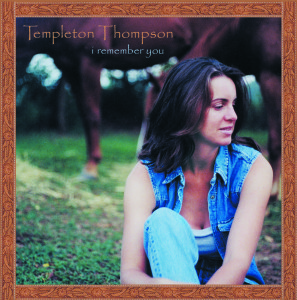
Templeton was born in Texas, and later lived in Virginia and Maryland. She was a shy girl and was embarrassed to sing out in front of people. But she always knew in her gut that music was what she was supposed to do.
Well-meaning folk told Templeton what she ought to do with her life, and she listened. Her family was high-achieving, with quite a few lawyers. She attended the University of Virginia and majored in English Literature. She took the Law School Admissions Test—and something happened that made her cancel her scores and stop the ball that was already rolling into a conventional future.
“I picked up a magazine that had an article about the ‘artist and repertoire’ departments of music labels, specifically in Nashville. I had grown up listening to Michael Martin Murphey, Linda Ronstadt, Dolly Parton, Emmylou Harris, the Eagles, Dan Fogelberg… I had no clue about how music was made there, and it interested me. I read about Trisha Yearwood, who happens to be one of my favorite singers on the planet, and she talked about being an intern at MTM Records in the A & R department, where they find songs for singers.” Templeton wrote letters to A & R departments in Nashville and asked to be an unpaid intern so that she could learn the record business.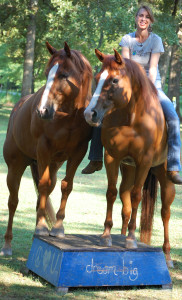
“I got a couple of responses, and I ended up being offered an internship with Arista Records, working for a wonderful man named Joe Tassi. Arista was a great label then, in the early 90s. They had Diamond Rio, Alan Jackson, Michelle Wright, and Pam Tillis. I said to myself, if Trisha Yearwood can be an intern at a record company, so can I! I can get my foot in the door and learn about writing songs.” Templeton loaded her car and moved to Nashville. She confesses that, at that point, she could play the guitar, but not very well, and that she had written at most one song. Templeton says, “Working at Arista was like getting a PhD in the music industry.”
Arista asked Templeton to “move along” when the higher-ups found out that she was a wanna-be singer. They said if she wanted to stick around and climb the music industry ladder, that was fine—but if she was using the position as a stepping-stone to a singing career, she had to go. “I ended up waiting tables a lot more than I already was. I just hunkered down and learned how to write songs. I got better on the guitar. And I got brave enough to start doing open-mic nights. I eventually wound up singing at the Bluebird in Nashville.”
Templeton met some people who were organizing a singer-songwriter tour to Normandie, France. Sam Gay, a fine musician and a new friend, came along on the tour, too. Templeton and Sam fell in love in Normandie. When they came back, they performed together at the Bluebird, and one night Jackie Chancey, head of a music publishing company, came up to Templeton and asked her if she was looking for a publishing deal. “I asked her, ‘What’s a publishing deal?’ I was clueless!” Fortunately Sam, who was an experienced singer-songwriter, knew that Jackie was offering a great opportunity. Soon Templeton was writing songs five days a week for Bizzy Music and getting her bills paid. 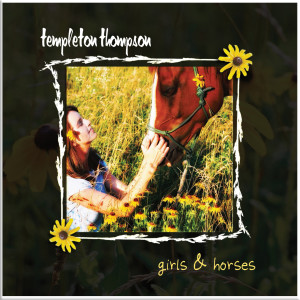
Six months into Templeton’s deal, Bizzy Music folded. But Templeton was blessed, as she puts it, to get signed by another publishing company almost immediately. “I wrote for Stewart Harris, an iconic singer-songwriter who has written songs for Travis Tritt and Wynonna Judd. After a year Stewart signed my husband, as well.” Templeton says that during her time with Stewart she really found her voice as an artist. “Stewart would leave us alone and just let us write our songs. We would record our demos in our little recording studio in our little house in Nashville.”
Templeton’s career took off when Reba McEntire recorded Templeton’s song “Where You End and I Begin.” She says, “I even got to sing on the record with Reba… and now I have a platinum record hanging on the wall!”
But the record industry was changing, and the songwriting deals dried up. Templeton and Sam decided to take control of their careers and hit the road. “We actually started singing our songs to people!” she says. The shy girl who had been afraid to sing out discovered that she loved performing. Her voice was ready, too: Templeton had been taking singing lessons in Nashville from the legendary teacher Norris Brannstrom. “If I ever have trouble figuring out how to sing a song, I just think of Norris, and it makes it easier.”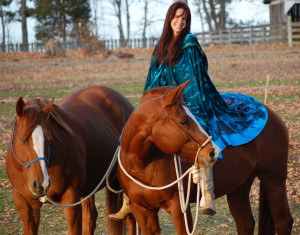
Being on the road brought more opportunity. Templeton admired a traveling show called “Jim Campbell and the Horsemen’s Radio Weekly Show.” Campbell would set up a talk-show type set at horse expos around the country and entertain. Templeton decided that she would send Jim Campbell a copy of her first album, “I Remember You,” in which she returned to her “horse roots.” She says, “You just sort of chunk things out into the universe and see what happens. You don’t know if you don’t try. I’d been writing songs from the backs of my horses since I was able to ride. Horses are my muses and my babies.” Mandy Hammond, who worked on the show, loved the music, and Mandy, Jim, Templeton, and Sam became close friends. Through the Radio Weekly Show, Sam and Templeton began bringing their music to horse people.
Templeton and Sam have developed a lovely act that features the close relationship of Templeton and her horse Jane, a sorrel Quarter Horse. “I sing from Jane’s back and then I set her loose to play at liberty while I sing from the ground.” Jane gallops, circles, bows, and rears on command—as if she, too, is communicating the beauty of the music. “Her name should really be Rockstar Incredible Fantabulous Jane!” says Templeton. The Breyer company was so impressed with Jane that they created a model of her. Templeton, Jane, and Sam performed at BreyerFest in 2009.
Templeton also owns Jane’s half-brother, Beau. The two horses, born two weeks apart, look almost identical: copper penny sorrels with big blazes. Beau is a tad taller and sports more muscle than Jane, even though he is the Appendix Quarter Horse. “On his dam side he goes back to Alydar. But he looks much more like a typical Quarter Horse, big and stocky. Jane is more leggy, like a Thoroughbred.” Templeton is proud of her horse family. “I am a very grateful mama cowgirl.” In the past, Jane has been Templeton’s mount for arena performances. Templeton hopes to perform with both horses in the future.
Templeton doesn’t compete on her horses. They have enough to do, working on performing for the horse-loving public. Templeton actively pursues knowledge of horse training. She admires Buck Brannaman’s horsemanship. She is interested in the vaquero method of bringing a horse along, slowly and kindly. She is impressed by finesse. “My dream,” she says, “is to have both of my horses straight up in the bridle.”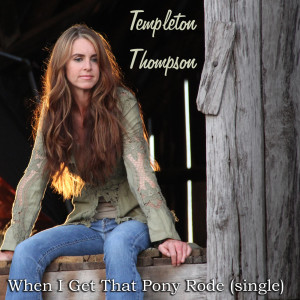
Templeton says, “I am a sponge when we are on the road!” She and Sam get to meet many accomplished horsemen and horsewomen. Templeton has discussed training methods with Mary Miller Jordan, Stacy Westfall, Clinton Anderson, Chris Cox, and the Parellis. “I don’t meet a stranger. I go out and talk to all these folks.”
Templeton and Sam are grateful to the enthusiastic audience at the 2013 Dixie Nationals. The duo had just completed the video for their song “When I Get That Pony Rode.” Templeton sang the song and asked the crowd to check out the video. “It was that audience that started the voting for the video,” she says. “The next weekend the video debuted on CMT.com and went on to #1 in its first week of release.” http://www.cmt.com/videos/templeton-thompson/880040/when-i-get-that-pony-rode.jhtml
Cindy Meehl, director of the movie “Buck,” directed the video for “When I Get That Pony Rode.” Jane and Templeton star in it, but Beau and Sam are in it, too. The song is about getting bucked off and getting back on, but like all things having to do with horses and humans, it’s about much more: communication, perseverance, trust. You can find it on YouTube at https://www.youtube.com/watch?v=vG-KiZxUFnM
“Girls and Horses,” which Templeton premiered at BreyerFest 2009 (with Jane’s help), can be seen at https://www.youtube.com/watch?v=84crwQZVIgg
On Templeton’s website ( http://www.templetonthompson.com/ ) you can also hear Sam’s expert guitar playing and fine baritone. Sam arranges and produces all of Templeton’s music. The end result makes fine listening. Templeton plays rhythm guitar and leaves the fancy riffs to Sam. Although she is right-handed, she plays a left-handed guitar. She damaged her left hand in a horse accident when she was sixteen. As a result, she strums with her left, and fingers chords with her right. “When I first moved to Nashville in 1992, I got a left-handed Guild guitar. I call her my Guildy Girl. She’s beautiful and blonde. She’s got lots of character—cracks in the varnish—from me leaving her in the car when it was too hot, in Texas. She sounds fine. The guitar was a really sweet gift my parents gave me.” Templeton discovered that her guitar is one of the last Guilds made in America. “I’ll never get rid of her!” she says.
Sam and Templeton also compose and record for film and television. Visit http://connectedatthehit.com/ to check out their projects.
And their newest project is recording Templeton’s #GetThatPonyRode album. Templeton has a great relationship with her fans, who stepped up and helped fund the recording through Templeton’s IndieGoGo crowdsourcing campaign.
Templeton is an ambassador for EAGALA (www.eagala.org) , the Equine Assisted Growth and Learning Association. EAGALA, a nonprofit, was founded in 1999 to promote Equine Assisted Psychotherapy and Equine Assisted Learning. Two factors distinguish EAGALA from therapeutic riding programs: 1) licensed mental health professionals and equine professionals work together to help the clients with their interactions with the horses, and 2) all work is done on the ground, not in the saddle. It makes sense for Templeton to represent EAGALA: the highlight of her arena performances with Jane is the expressive work they do together after Templeton dismounts. 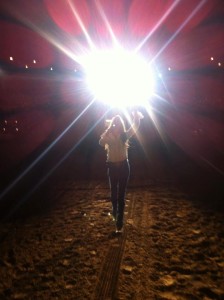
Templeton believes that humans and horses have the ability to connect, mind to mind and heart to heart. Horses communicate in complex ways, even if they cannot use words. We have to train our senses to catch what the horses are trying to say. Like listening to unfamiliar music, “listening” to your horse takes patience and concentration. Templeton knows this well.





